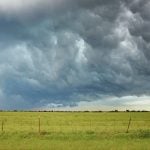The Manitoba government will spend $100 million to lower record water levels that flooded farms and forage land around Lake Manitoba this spring and summer.
The emergency channel between Lake St. Martin and Lake Winnipeg is necessary because doing nothing is not an option, Manitoba premier Greg Selinger said yesterday during an afternoon press conference,.
“If no action is taken now, hundreds of properties around both lakes will be threatened by flood waters for an extended period,” said Selinger.
Water levels in Lake Manitoba reached 817 feet above sea level in July, five feet higher than the maximum regulated level for the lake. The rising water swallowed up pastureland and hay land that surrounds the lake, forcing cattle producers to move stock inland or relocate herds to other locations on the Prairies.
Farmers, residents and cottage owners around the lake held several meetings this spring to express their anger about the flooding. Many people believed the provincial government’s decision to divert flows from the Assiniboine River into Lake Manitoba was the principal cause of high water levels on the lake.
Water from Lake Manitoba and the surrounding watershed also flooded the community around Lake St. Martin, which is located near Gypsumville, Man.
Lake Manitoba drains into Lake St. Martin via a control structure at Fairford, Man.
The province’s plan is based on the recommendations of two engineering consulting firms, which the government hired following this spring’s flooding.
Work will begin immediately on the Lake St. Martin to Lake Winnipeg emergency channel, which will be eight kilometres long, 90 metres wide and seven metres deep. If all goes according to plan, the work will be completed by early November.
Once the work is complete, the province plans to operate the Fairford outlet at full capacity throughout the winter of 2011-2012, Selinger said.
“This is expected to bring both lakes down two or three feet by next spring.”
Into the future, the channel would provide a safeguard for flooding of Lake Manitoba and Lake St. Martin, Selinger added.
“It’s like the (Red River) floodway. It’s there when you need it.”
The province has budgeted the potential of a 30 percent cost overrun into the project, which would push the price tag up to $130 million.
The Manitoba government expects the federal government to pick up 90 percent of the cost, but Selinger said Ottawa hasn’t yet agreed to fund the project.
“We believe that it is completely eligible under the disaster financial assistance program.”











